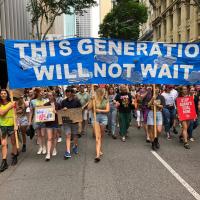I don't often repost, but this article is critical reading for researchers, decision-makers, policy-makers, practitioners and civil society. From the Standford Social Innovation Review.
By Amy Luers, Carl Pope, & David Kroodsma | 8 | Aug. 19, 2013
In June, President Obama’s signature speech on climate change elevated adaptation and preparedness in the national climate conversation, reinforcing a trend that has emerged throughout the environmental community. Although climate advocacy groups have historically avoided any mention of adaptation and preparedness—largely for fear that it would distract from mitigation—today they are embracing these terms as core to their climate narrative. This is a promising shift, as we need to develop a more holistic approach to managing climate risks.
However, despite this shift, the programmatic agenda of the climate advocacy movement has not yet caught up with this new narrative.
Climate risks of the here and now
Climate advocates are increasingly bringing attention to the risks of the here and now. A quick look at the press releases from some of the major environmental NGOs makes this apparent. As illustrated in Figure 1, since 2006 there has been a steady increase in the number of press releases in which major climate advocacy groups emphasize current climate risks—such as todays’s wildfires, hurricanes, droughts, and ecosystem impacts—instead of emphasizing similar risks far in the future.

Figure 1. Trends in major NGO press releases.1
The severe drought and wildfires that have swept the nation in recent years, topped off by the devastation of Superstorm Sandy, have put climate risks back in the media and the American mind. And climate advocates are making sure that the public makes the connection between these events and the changing climate. However, a review of the annual reports and websites of these major climate advocacy groups reveals no significant shift toward prioritizing adaptation in their agendas—the advocacy groups’ documents and websites make scant references to programs focused on adaptation.
Separate but not equal
One major reason that climate advocacy groups haven’t fully embraced adaptation is that the climate mitigation and adaptation communities are two distinct groups. The climate mitigation community is largely made up of engineers, economists, and policy wonks, along with activists who are committed to “fight the good fight.” Meanwhile, the adaptation and preparedness community is mostly populated by geographers, sociologists, and ecologists, together with development aid personnel, hazard risk managers, and disaster responders, who are committed to solving problems and saving lives. Despite the converging narratives of these two communities around current climate risks, there remains very little overlap in the work they do. This is apparent when comparing the NGOs participating in the National Adaptation Forum, one of the first major national adaptation-focused meetings, with members of the US Climate Action Network (USCAN), the largest network of NGOs working on mitigation-focused climate advocacy. Only a handful of NGOs participated in both.

Figure 2. NGOs that are members of USCAN or attended the National Adaptation Forum.2
To effectively address the climate crisis, we must strengthen ties between the mitigation and adaptation communities.
The here and now is about adaptation
Addressing the here and now of climate change is largely about adaptation, as we cannot address the climate risks of today by reducing emissions of heat-trapping gases. Instead, tackling today’s climate risks requires better infrastructure and institutions. But mitigation advocates shouldn’t see acknowledging the need for adaptation as defeat. Many effective policies to address adaptation can, if properly structured, have positive mitigation effects. Efforts on adaption may also drive awareness of the costs of climate change, building support for more aggressive mitigation. We need to move beyond talk about the “here and now” of the climate challenge to look for deeper integration of our programmatic agendas. To start, we need a better dialogue between these communities.
Identifying synergies and avoiding conflicts
The scientific community has identified potential synergies, trade-offs, and conflicts between mitigation and adaptation activities. In practice, however, the adaptation and mitigation communities have distinct foci that inhibit collaboration. Better integrating these communities will help identify synergies, understand the trade offs, and avoid potential pitfalls.
Adaptation needs a strong advocate.
The adaptation and preparedness community does not have the battle-tested political savvy of the mitigation community. Advocacy organizations are critical partners for setting agendas and engaging policy makers to push from planning to action on adaptation. Unlike with mitigation, where we know what we need to do—transition away from fossil fuels—with adaptation, the strategies are less clear. There are many uncertainties, and many risks of maladaptation and corruption. To get it right, we need to be attentive to science, politics, and the experiences of our communities. That will take all climate advocates and adaptation practitioners working together.
1 We reviewed press releases from a representative sample of major NGOs: Environmental Defense Fund, World Wildlife Fund, the Union of Concerned Scientists, The Sierra Club, Natural Resources Defense Fund, Greenpeace USA, and Earthjustice. Note that the numbers don’t add to 100 percent in any given year because some press releases mentioned both or weren’t clear about when the impacts would occur.
2 Circle size is proportional to the organization’s estimated climate and energy budget. All organizations with an estimated climate budget under $2 million are the same size. All of the organizations whose press releases we reviewed for Figure 1 are members of USCAN.
- Log in to post comments



CRC Comments